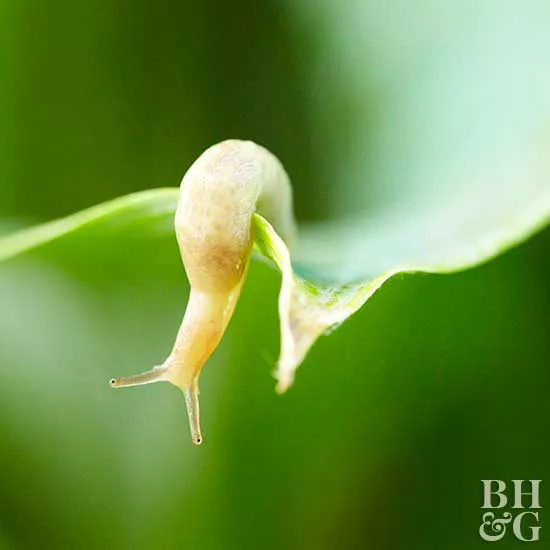The telltale sign of slugs in gardens—besides your plants being eaten—is the silvery trail they leave behind, so understanding how to get rid of slugs will be helpful. Slugs do the most damage at night. They particularly like young, tender plants and can eat the entire plant or leave large, ragged holes in foliage. They eat leafy greens, like lettuce, and might even eat fruits or vegetables touching the ground, such as strawberries, tomatoes, or squash. Hostas are a favorite ornamental for slugs to dine on.
How to Get Rid of Slugs In a Garden
The best bet to reduce slugs in gardens is to eliminate places they like to hide. They want damp, dark areas under boards, rocks, garden debris, and flower pots. Any of these items work as lures. Check under them each day and get rid of any slugs you find. Repeat daily until the slugs are gone. Adding decaying fruit underneath a board in a damp area will also draw in slugs so you can remove them. Wearing rubber gloves, throw the slugs in a plastic bag, seal them, and throw them away.
How to Get Rid of Slugs with Beer
Slugs seem to be attracted to yeast. Beer placed in a small, steep-sided dish or a discarded food container with a lid is one of the tried-and-true traps they can't resist. If you want to keep other creatures from drinking the beer, cut two or three openings about one inch wide in the side of the container, all at the same height. Add beer or a yeast-and-sugar-water mixture just below the openings. Put the lid on the container and bury the container up to the holes. The slugs will crawl into the beer trap and drown.
More Methods for How to Get Rid of Slugs
Slugs can hide under larger wood bark mulch, but they dislike pine needles, making it a good mulch choice where slugs are significant pests. Another method to protect plants is to sprinkle abrasives such as dry ashes or food-grade diatomaceous earth around plants. These abrasives are potent irritants to slug skin. Slugs also like to congregate underneath outdoor decorative rugs on patios and decks. Sprinkling diatomaceous earth under the outer perimeter of the rug can help keep them at bay. Repeat periodically, as this abrasive becomes ineffective when wet.
How Does Slug Bait Work?
Baits are available on the market, such as the brands Escar-Go! or Sluggo. When using baits, place them near dark, damp garden areas where slugs typically hide. Follow the label directions and repeat as necessary. With a combination of strategies, the slug population in your garden should decrease or disappear.
The active ingredients in most baits are toxic to humans, dogs, and cats, so use them safely and store them securely.
Companion Plants Keep Pests Away
Companion plants are a non-toxic and often decorative way to keep pests from attacking your vegetables. Plant alliums with broccoli since allium's scent is unpleasant to aphids, slugs, and cabbage worms, which will chew on broccoli plants when they can. Onions will keep carrot flies from destroying carrot plants, and they're a good choice because the two plants need the same type of soil. Tomatoes are vulnerable to many pests, but planting basil with them will keep thrips from attacking the tender fruit. Choosing the right companion plants can save your garden from being destroyed.




















